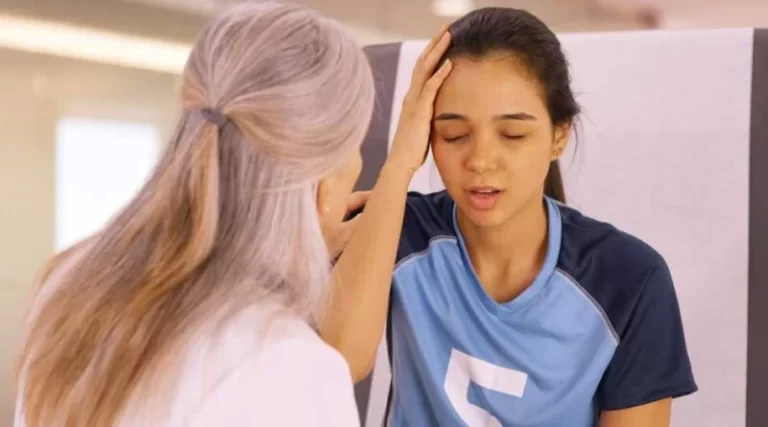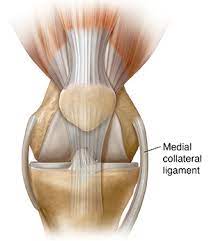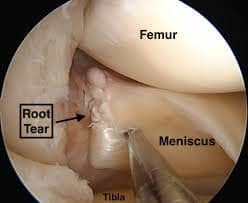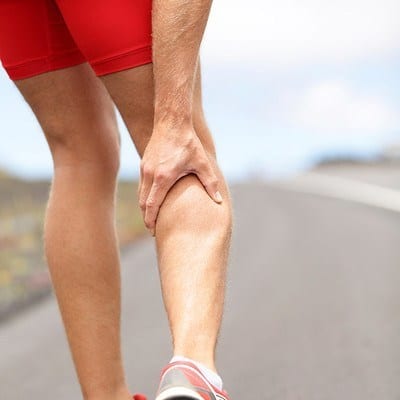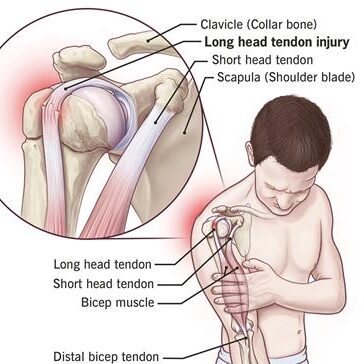Rotator cuff muscle strain
Table of Contents
What is rotator cuff muscle strain?
- A rotator cuff muscle strain is simply a tear of one of the four rotator cuff muscles found in the shoulder. These are the teres minor, and subscapularis. supraspinatus and infraspinatus, The muscles work together to give the shoulder joint dynamic stability. This means they help keep the joint stable while it moves, especially in overhead throwing and chatter sports.
- Rotator cuff injuries are very common, particularly in people over 40, athletes, and people whose work involves constantly lifting their arms above. Conservative treatments are generally successful.
- The shoulder joint has a very large range of motion( compared to the hip joint) and again and again, needs to move at veritably high speeds. As a result, there’s a higher risk of harm to the muscles and tendons. The supraspinatus and infraspinatus are the most generally strained rotator cuff muscles, especially in cricket bowling, pitching in baseball, swimming, and kayaking.
Where is the rotator cuff muscle located?
- A rotator cuff is a group of four muscles that keep your upper arm in place in your shoulder. It helps you make all the movements of your arm and shoulder.
- The head of your upper arm bone, also known as the humerus, fits into the socket of your shoulder blade, or scapula. When you extend your arm out down from your body, the rotator cuff muscles keep it from popping out of the socket, or glenoid.
Anatomy
- Four muscles make up the rotator cuff: the subscapularis, infraspinatus, supraspinatus, and teres minor. Together they assist in holding the shoulder joint as well as in doing different arm movements.
- Four muscles and their attached tendons create the rotator cuff. Each of them aids in a specific movement of your shoulder. Together they help keep your upper arm stable in the shoulder socket.
- All four muscles group originate in your shoulder blade, but the other end of the muscle leads to a different region of your upper arm bone.
The acronym SITS may help you remember these four muscles:
- Supraspinatus is working for movement away from the center line of your body (abduction). The supraspinatus works are about the first 15 degrees of movement. After that, your deltoid and trapezius muscles work.
- Infraspinatus is the main muscle work for lateral rotation of your arm aside from the center line of your body. It’s a thick triangular muscle. It warps the back of your shoulder blade deep below the skin and near the bone.
- Teres minor is a narrow, small muscle on the behind of your shoulder blade just behind the infraspinatus. It also contributes to the external rotation of your arm.
- Subscapularis is a large triangular-shaped muscle that lies behind the other three. It’s the largest, strongest, and maximum use of the four rotator cuff muscles. It participates in most shoulder movements but is especially important for the rotation of your arm toward the midline of your body (medial rotation). different from the other three muscles, the subscapularis attaches to the front, not the back, of your upper arm.
Rotator cuff muscle strain classification
- Grade 1 will lead to a small tear of muscle injury resulting in some pain and discomfort but still having full function.
- grade 2 moderate tissue injury leading to a significant loss in motion is a Grade 2 rotator cuff muscle strain.
- Grade 3 Rotator cuff muscle strains will be the Rotator cuff muscle fibers that have been torn resulting in a full rupture and major loss of Shoulder function.
What causes rotator cuff muscle strain?
- Rotator cuff strains are more common in older athletes, mainly if they have a history of long-time overuse. This causes degeneration of the rotator cuff muscle tendon (wear and tear).
- In throwing activities it is often the case that injury is caused by rapid movement or stopping of the arm once the throw has been released, rather than the rapid movement of the throw.
- This is why it is specifically important to strengthen the muscles at the back of your shoulder if you are involved in throwing sports, not just the throwing muscles!
Symptoms of rotator cuff muscle strain
Rotator cuff muscle strain sing and symptoms at the time of injury will involve:
- Unexpected pain in the shoulder joint may range from quite mild to severe.
- It’s sometimes encouraged by a feeling that you have torn something in your shoulder.
- Rotator cuff muscle Pain may radiate into your arm.
- Sometimes a snapping sound can be noted, particularly if the injury is more severe
- You’ll often be unable to sleep on the injured shoulder as a result of the pain.
- You may have signs of shoulder impingement. This is where the tendon pinches between your shoulder joint, especially when move your arm overhead
Rotator cuff muscle strain diagnosis & assessment tests
There are many shoulder injuries that may have similar symptoms. So to identify rotator cuff injuries, a professional therapist will do some special tests for rotator cuff injury. This helps isolate the rotator cuff muscles and reproduce symptoms.

1) Empty can test
- This is the most common rotator cuff strain diagnosis test. You will be calling patients to put their arm out ahead of you at a 45-degree angle to your body, with the thumb pointing to the floor like you holding an empty can. The therapist will ask you to up your arm whilst they resist your movement. This tests the Supraspinatus tendon.

2) Drop Arm Test (Codman’s Test)
- Your arm will be moved above your head, and you’re calling him to slowly lower your arm to your side. If you can’t do this slowly and under control or have severe pain in doing so, it indicates a tear in the rotator cuff, particularly Supraspinatus.
3) Abrasion Sign
- You will call him to sit and up your arm to your side with the elbow bent. You will call him to rotate your arm backward and forwards. If there is any crepitus (crunching noise) there may be some inflammation or degenerative changes.
4) Neer’s Sign
- The physiotherapist will position your arm with the thumb facing down and at a 45-degree angle to your body. They will then lift your arm raise, above your head. If you feel pain or discomfort, you may have an impingement of supraspinatus.

5) Hawkins- Kennedy Test
- Your arm will be raised in front of you to 90 ° and the elbow bent. The therapist will also medially rotate( turn the wrist down and elbow up) the arm. If this movement causes pain you probably have an impingement of Supraspinatus.
Assessment
Subjective assessment
History with associated symptoms
Mechanism of injury:
Inciting trauma-direction-and magnitude of injury force
Repetitive trauma-faulty postural-related injuries
On objective assessment, there will be:
Muscle Tenderness
Swelling
Bruising may appear within hours or days
Stretching of the muscle will reproduce pain
Treatment of rotator cuff muscle strain
- Treatment of rotator cuff muscle strain depends upon the severity of the injury, Doctor examines you, depending on the severity of the injury, the conditions, and the assessment plan of treatment.
- The most significant time in the initial treatment of a rotator cuff muscle strain is the first 24 – 48 hours. This is when the increase of bleeding and swelling around the injured muscle occurs. To control the swelling of injured muscle and, therefore, limit the stage of injury to the rotator cuff muscle, the muscle should be treated rested and iced.
- If the patient has grade 1 (mild) and grade 2 (moderate) muscle strains then the patient should take rest, apply ice and take painkillers. grade 1 and grade 2 muscle strains take 3 to 6 weeks to recover. Patients with grade 3 muscle strains should undergo surgery. grade 3 muscle strain takes around 10 to 12 weeks to recover.
Medical Treatment
For immediate
- Some therapists advise avoiding harmful painkiller medicines that can extend your threat of bleeding — similar to over-the-counter (OTC) medicine (naproxen sodium (Aleve) aspirin and ibuprofen (Advil, Motrin IB), — during the first 48 hours after a rotator cuff muscle strain. Acetaminophen (Tylenol) and others can be helpful for pain relief during the starting period.
- A physiotherapist may help you to improve the muscle strength and joint stability of the injured joint or limb. Your doctor may suggest that you stabilize your shoulder with a brace. For some muscle injuries, rotator cuff muscle sprint surgery may be called.
Hot and cold therapy
- Cold therapy can help ease your pain and reduce inflammation of the muscle. Apply a cold pack to the injured area for 15 to 20 minutes at a time, 3 to 5 times a day for the first two days. You may use an ice pack, a gel cold pack, or a plastic bag filled with ice.
- After an injury in the first 48 hours, you may want to start using heat on the injured area. Heat may help relax and loosen the muscles so you can do your routine life. You may apply heat for 15 to 20 minutes at a time with a heating pad or a damp warm towel.
Physiotherapy treatment
The aim of activity treatment is
- Decrease pain in the shoulder,
- Reduce rotator cuff muscle swelling
- Allowing time for the tissue to undergo the healing process and decreasing ongoing stress on the rotator cuff muscles.
- Improve full pain-free range of motion in the shoulder joint.
- Restore full functional activity.
Phase one: one to two weeks
Physiotherapy rehabilitation can be started after 48 hours of injury, For the first few days give an electric modality to relieve muscle swelling and muscle pain
Ultrasound
- Ultrasound has been used for tissue healing
- Increases blood circulation and mobility.
- To reduce swelling and pain
Cryotherapy
- Inflammation and swelling can be decreased by applying cryotherapy in form of ice packs, and cold water baths to the affected area. Continuous application of colds several times a day for 15-20 minutes at a time is recommended.
TENS
- Transcutaneous electrical nerve stimulation (TENS) may be able to help decrease muscle pain and muscle spasms.
Phase two: three to six-week
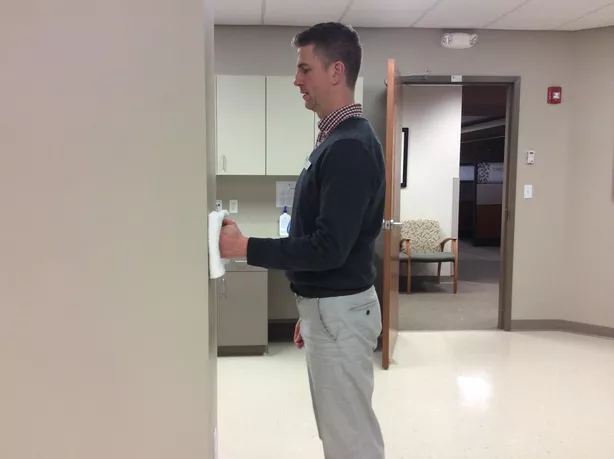
- Isometric shoulder flexion exercise
To do this isometric shoulder flexion exercise you are standing to face a wall.
Try to flex your elbow on the side of the shoulder then make a fist.
You Place the folded napkin in between your fist and the wall and slowly press your hand into the wall.
Hold this pressing for 10 to 15 seconds then slowly relax.
Do the 10 to 15 repetitions.
2) Isometric shoulder abduction exercise
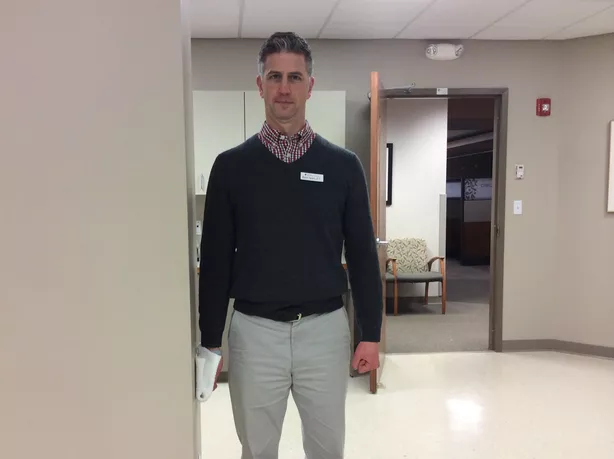
This exercise is most useful for your rotator cuff muscles.
To perform shoulder abduction you stand 15 to 20 cm away from the wall.
Then turn your body perpendicular to the wall and close to the wall at the side which is affected by the shoulder joint side.
Make a fist on that side and press the towel into it.
You are also using a folded towel for support.
You are only gently pressed into the wall, try to lift your arm outside.
Hold this position for 10 seconds then slowly release pressure from the wall.
Do the 10 to 15 repetitions.
3) Isometric shoulder external rotation exercise
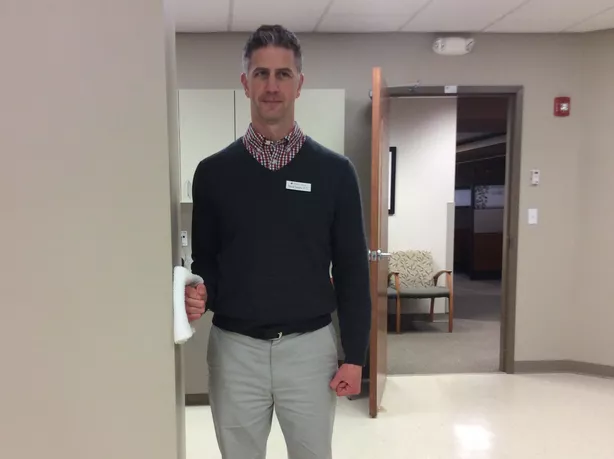
This exercise helps to strengthen your rotator cuff muscles, mostly teres minor and infraspinatus.
To perform external shoulder rotation you stand perpendicular to a wall about 18 cm from the wall.
The strained shoulder joint is near the wall.
First bent your elbow joint up to 90 degrees then make a fist.
Then press the towel from the back of your hand into the wall as you rotate your arm outward side.
Then slowly press the towel into the wall.
Hold this position for 10 to 15 seconds then slowly release the pressure from the wall.
Do 10 to 15 repetitions.
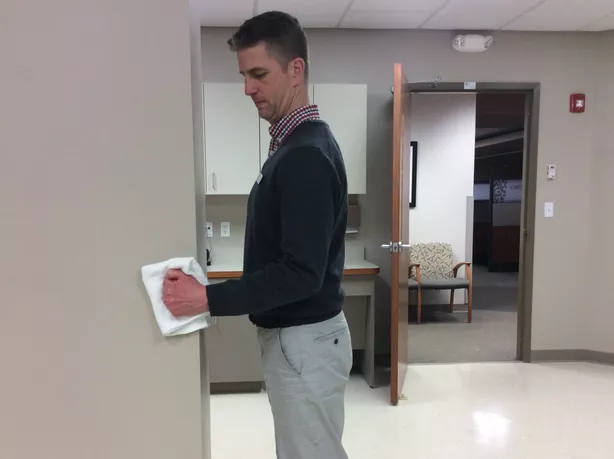
4) Isometric Shoulder internal rotation exercise
To perform shoulder internal rotation you are standing facing a door frame and outside the wall corner.
The painful shoulder joint is closed to the wall corner.
Then bend your elbow joint up to 90 degrees and make a fist.
Try to slowly press the towel into the corner wall, or door jamb as you rotate your arm inward towards your belly.
Hold this for 10 to 20 seconds then slowly back to starting position.
Do the 10 to 15 repetitions.
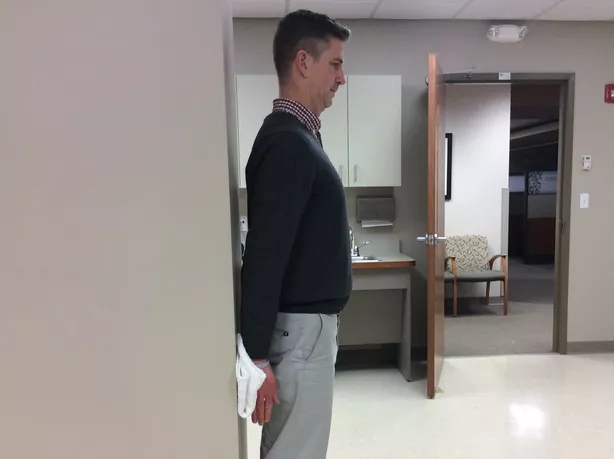
5) Isometric Shoulder Extension exercise
To perform shoulder extension you are standing to 15 t 20 cm away from the wall and your backside is facing the wall.
Your elbow joint is straight so your hand stays just close to your buttocks and makes a fist.
Then slowly press the towel into the wall behind you.
Hold this pressing for 10 to 20 seconds then slowly back to starting position.
Do the 10 to 20 repetitions.
6) Shoulder pully exercise
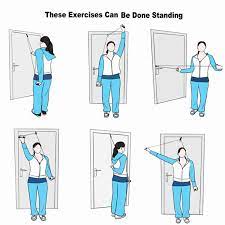
The pully exercise is used for the shoulder active assisted exercise.
First, hold a rope–pully on both hands then do the movement of the shoulder.
Shoulder flexion and extension, shoulder abduction, and shoulder external and internal rotation.
Do 10 to 15 repetitions
For progress do more repetitions
7) Wand exercise
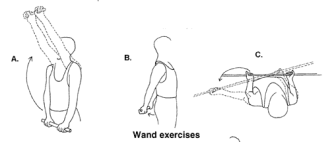
This exercise is helpful to you for improving the Range Of Motion for the shoulder.
You may keep the wand with the help of both hands.
Then do the shoulder and elbow joint movement.
Shoulder flexion and extension, abduction and adduction,
external and internal rotation of the shoulder
Elbow flexion and extension of this movement with the wand.
Every movement performs for 10 to 15 repetitions.
8) Shoulder pendulum exercise

The patient is in a standing position beside a table with the hand of the unaffected shoulder on the table and feet slightly wider than shoulder-width apart.
Then Bend the hip joint approximately 75 to 90 degrees and let the affected arm hang down toward the floor.
Shift the weight from side to side, letting the arms swing freely from side to side.
Shift the weight forward and backward, letting the arms swing freely front to back.
Once they feel comfortable with these movements, move the body so that the arm swings in a circle.
Must be Keep the circle small, less than 20 to 30 cm.
Continue for 30 seconds.
Every day, increase the time to 2 to 3 minutes.
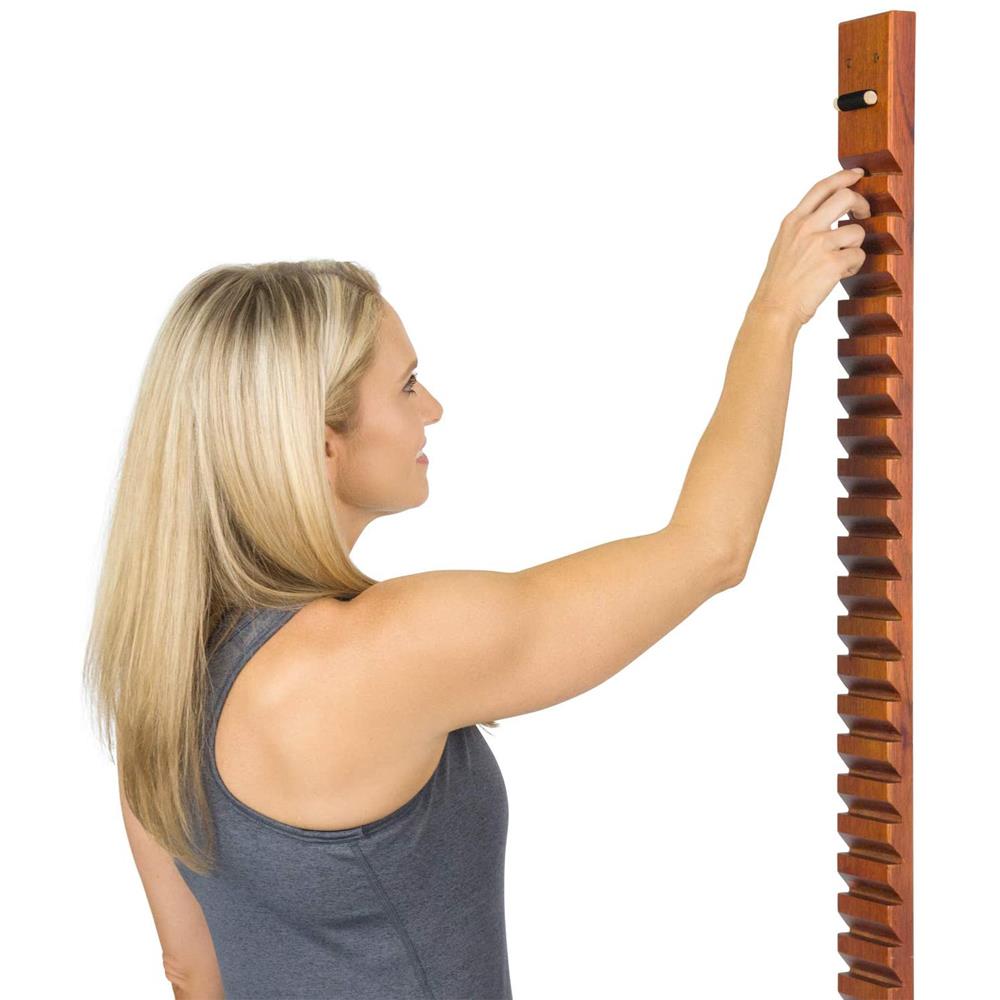
9) Finger ladder Exercises
The patient is in a standing position and facing a ladder that is hanging over a wall.
Ask them to patient place the affected hands on the ladder at a low level.
Then slowly start an upward climb on the finger ladder till it reached the top and slowly down back to the starting point.
Do 10 to 15 repetitions.
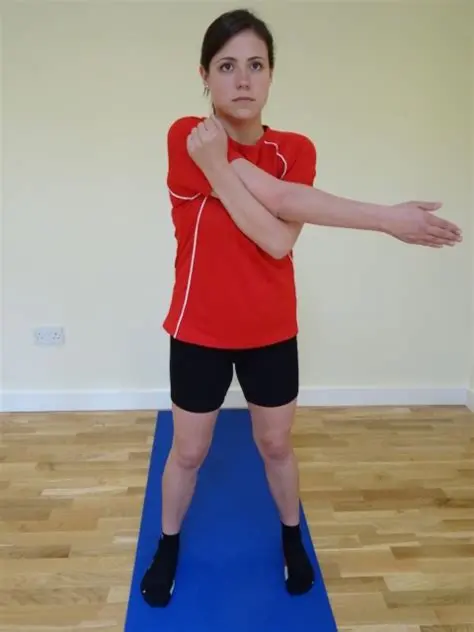
Phase three: seven to twelve week
1) Cross-arm stretch
Relax both shoulders and slowly up one arm across the chest as far as possible, holding at the upper arm.
Hold this stretch position for 20 to 30 seconds and then relax for a few seconds.
Repeat this on both sides.
2)Lateral raises
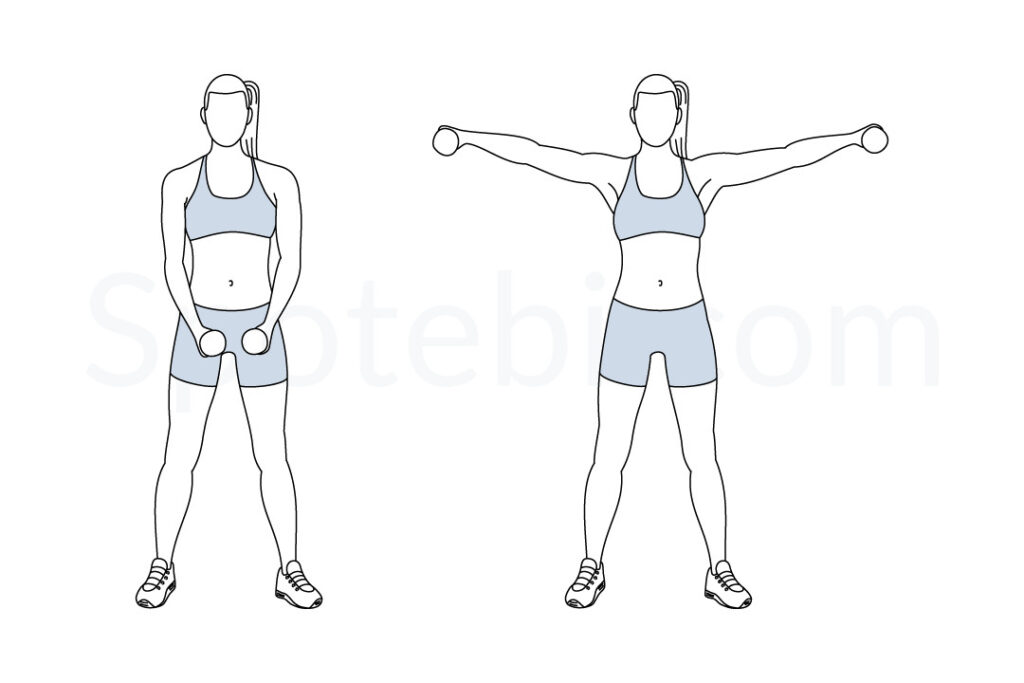
First, hold a pair of lightweight dumbbells in both hands for this exercise.
You are standing with the feet gently wider than the hip joint width apart.
Try to raise the weights to the sides up to shoulder level.
Must be remembered to engage the core muscles and slowly lower the weights down to the sides.
Do 10 to 15 repetitions.
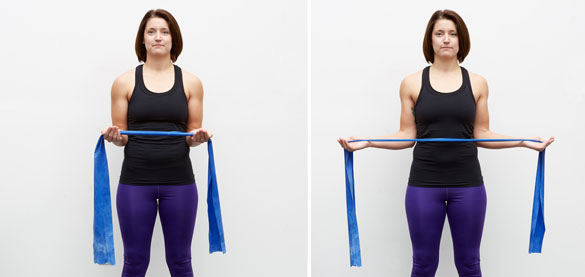
3) External rotation of the shoulder
First, holds the light theraband in both hands.
Must keep both arms at the sides of the body, and bend them at the elbow joint.
Then keep one arm still and rotate the other away from the body while maintaining the 90-degree elbow bending.
Hold this exercise position for 5 to 10 seconds then slowly back to the return position.
do 15 to 20 repetitions
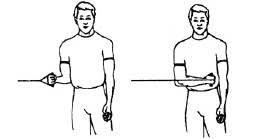
4) Internal rotation of the shoulder with theraband
First, attach a theraband to a doorknob.
The other end of the band is held in your hand.
Try to bend the arm at the elbow joint and pull the forearm toward your body.
Hold this exercise position for 10 to 15 seconds and slowly back to the starting position.
do 15 to 20 repetition
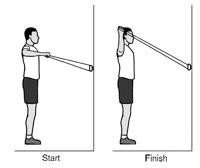
5) External Rotation With Arm Abducted 90°
First, make a 3-foot-long loop with the elastic band and tie the ends together.
Then attach the loop to a doorknob and another stable object.
just reaming your shoulder joint at elbow level.
Try to raise your hand up to line with your head.
Then slowly back to the starting position.
Do 15 to 20 repetitions.
6) External Rotation exercise with Band
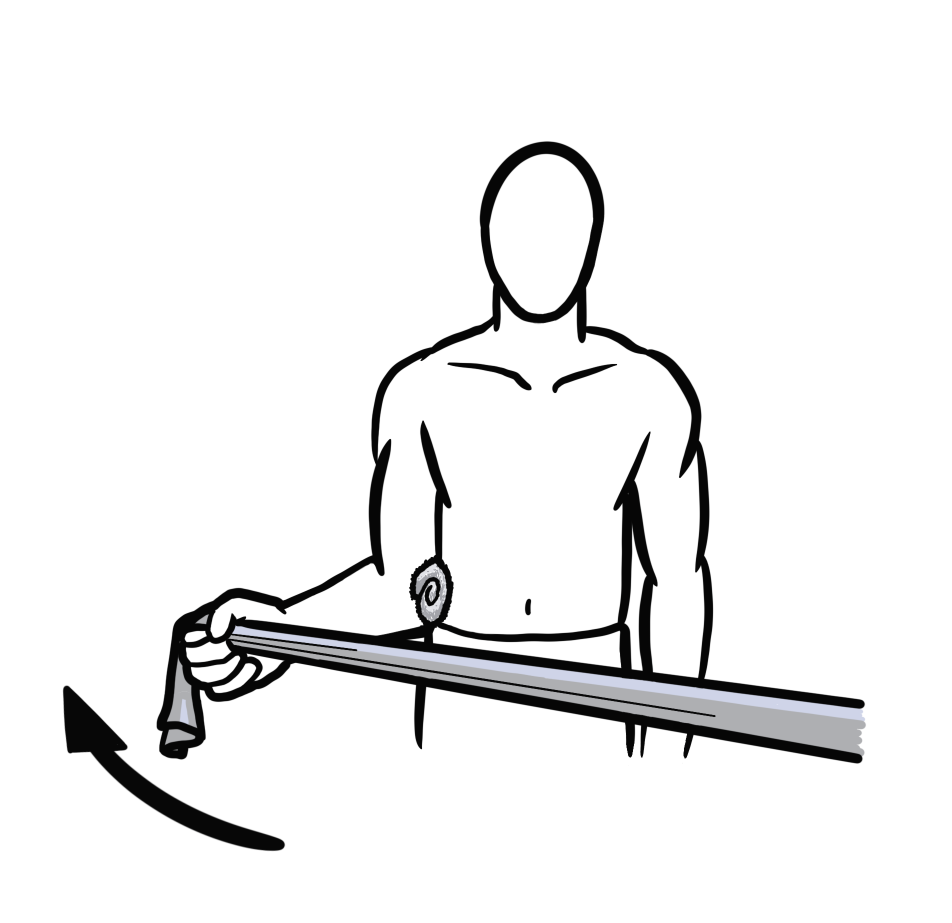
First, tie a resistance band to a stable object at the elbow joint level.
You are holding theraband with the use of your hand in an overhand grip.
For this exercise, you stand tall and bring your elbow joint up so that the upper part of your arm stays in line with your shoulder joint.
Try to bend your arm at the elbow joint 90 degrees and place the forearm running parallel to the floor.
Then externally rotate your hand and forearm means away from your body.
just remain your elbow at your side.
Then Reversing the movement back means a back to the starting position.
Do this exercise for 5-10 reps.

7) Internal Rotation Exercise Band
You are using a door or stable object to tie the band at waist height.
You are standing 3 to 4 feet away from the door.
Then hold your head straight and just keep your abdominal muscles tight.
In this exercise point your active arm so that it is parallel with the floor, pointed away from your torso at a 45-degree angle.
Try to Internally rotate your arm opposite the resistance band.
Then touch your torso with your hand.
Do 15 to 20 reps on both arms.
Prevention of rotator cuff muscle strain
- Warm up before some exercise or sporting activity
- Stretch after exercising or playing sports
- Stop immediate intense muscle strength training and build strength gradually
- Perform regular muscle stretching and muscle strengthening exercises for your sports, fitness, or work exertion, as a part of your daily physical activities
- An exercise program may help to decrease your danger of muscle strains.
- If you have physically demanding work, regular exercise can help to decrease injuries.
FAQs
- How do you treat a strained rotator cuff?
Treatment may include:
Rest.
Non-steroidal anti-inflammatory (NSAIDs) medicines.
Ultrasound therapy.
Strengthening and stretching exercises.
Corticosteroid injection. - How long does it take for rotator cuff strain to heal?
The minimum time for recovery from rotator cuff muscle strain or a small tear is generally two to four weeks, and severe injury may take several months. Early on, the aim is to decrease muscle swelling and inflammation of the tendons and relieve compression in the subacromial space
- What does a strained rotator cuff feel like?
In rotator cuff muscle injuries, the pain is felt at the anterior side of the shoulder joint. Because the rotator cuff enables shoulder movement and provides stability, problems in these areas suggest a rotator cuff is strained. Patients with rotator cuff strain have problems raising their arms and reaching behind their arms.
- What are the symptoms of rotator cuff muscle strain?
-Unexpected pain in the shoulder joint may range from quite mild to severe.
-It’s sometimes encouraged by a feeling that you have torn something in your shoulder.
Pain may radiate into your arm.
-Sometimes a snapping sound can be noted, particularly if the injury is more severe
-You’ll often be unable to sleep on the injured shoulder as a result of the pain.
-You may have signs of shoulder impingement. This is where the tendon pinches between your shoulder joint, especially when move your arm overhead - Wich exercise is used for rotator cuff muscle strain?
1)Isometric exercise
-Shoulder flexion, extension, abduction, and adduction
-Internal and external rotation of the shoulder
-Wand exercise
-Pully exercise
-Pendulum exercise
2)Stretching exercise
-Cross-arm stretch
3)Strengthening exercise
-Lateral raise
-Shoulder flexion with theraband
-Shoulder internal rotation with band
-External rotation with band


